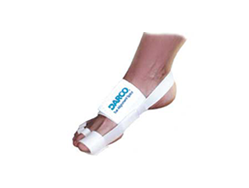Bunions Surgery Recovery
Overview
The bunion, or hallux valgus, is a condition that affects the bones and joints associated with the great toe. It is one of the most common deformities of the forefoot. The condition develops slowly and results from the gradual dislocation of the joint, usually because of instability during gait. There is a displacement of the first metatarsal bone toward the mid-line of the body, and a simultaneous displacement of the great toe away from the mid-line (and toward the smaller toes). This causes a prominence of bone on the inside (medial) margin of the forefoot, this is termed a bunion. As the deformity progresses, the big toe will shift toward the outside of the foot. In severe cases, the big toe will actually overlap or under lap the second toe. It is often of a hereditary nature, but it is also associated with rheumatoid arthritis and other diseases. There are no exercises, splints or other devices that reliably correct a bunion. Orthotics can sometimes slow or halt the progression by addressing the instability which causes the deformity, but they cannot reduce the deformity.
Causes
Causes of bunions are foot injuries, neuromuscular disorders, or congenital deformities. People who suffer from flat feet or low arches are also prone to developing these problems, as are arthritic patients and those with inflammatory joint disease. Occupations that place undue stress on the feet are also a factor; ballet dancers, for instance, often develop the condition. Wearing shoes that are too tight or cause the toes to be squeezed together is also a common factor, one that explains the high prevalence of the disorder among women.
Symptoms
Symptoms include pain in and around the ball of the big toe, usually from the bone rubbing too much against the shoe. You may be unable to wear certain types of shoes due to the shape of the forefoot. The big toe appears to be bent inwards towards and in come cases over the inside toe.
Diagnosis
The doctor considers a bunion as a possible diagnosis when noting the symptoms described above. The anatomy of the foot, including joint and foot function, is assessed during the examination. Radiographs (X-ray films) of the foot can be helpful to determine the integrity of the joints of the foot and to screen for underlying conditions, such as arthritis or gout. X-ray films are an excellent method of calculating the alignment of the toes when taken in a standing position.
Non Surgical Treatment
The non-invasive treatments for bunions are many and include changes in footwear, icing the sore area, over the counter pain medications, orthotic shoe inserts, and weight management. If these conservative measures fail to arrest your pain and discomfort, your foot and ankle surgeon may recommend a bunionectomy or similar surgical procedure, depending on your condition. 
Surgical Treatment
If your bunion has progressed to the point where you have difficulty walking, or experience pain despite accommodating shoes, you may need surgery. Bunion surgery realigns bone, ligaments, tendons and nerves so your big toe can be brought back to its correct position. Orthopedic surgeons have several techniques to ease your pain. Many bunion surgeries are done on a same-day basis, requiring no hospital stay, using an ankle-block anesthesia. A long recovery is common and may include persistent swelling and stiffness.